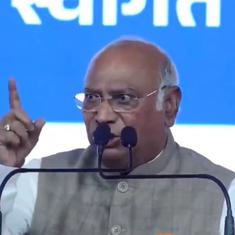It took six days and a lot of public pressure for Puducherry Lieutenant Governor Kiran Bedi to finally invite Chief Minister V Narayanasamy for talks on Monday to end the ugly deadlock in the administration of the Union territory. Since February 13, Narayanasamy and his Cabinet colleagues had staged a dharna outside the lieutenant governor’s official residence. They laid siege to both entrances of Raj Nivas, restricting Bedi’s movements.
Somewhat whimsically, the protest was sparked by Bedi’s decision to implement a rule making it compulsory for two-wheeler riders to wear helmets. She even took to the streets herself to ensure that the rule was enforced. But Narayanasamy insisted that the roots of his dissatisfaction went much deeper: he said that the lieutenant governor had stalled over 35 welfare schemes proposed by his government. That made it clear that the ruling Congress believes that it will be difficult to fight the Lok Sabha elections if it fails to deliver these welfare schemes it had promised the electorate.
Be that as it may, the protest brings back focus on the precarious arrangement of the administration in the Union territories of Puducherry and Delhi. The two entities have elected Assemblies and seem to function like state governments. But in reality, these Union territories are administered by the Centre through lieutenant governors, who have veto powers over the elected chief ministers.
Last week, the Supreme Court held that the subject of public services was beyond the powers of the Delhi government. The Centre is the sole authority over this area, the court said, which meant that Chief Minister Arvind Kejriwal has no say in posting and transferring officers in his own government. This judgement came months after the Supreme Court declared in July that the lieutenant governor has to act on the advice of the council of ministers on all matters except in the specifically excluded areas of land, police and public order.
Over the last two years, Puducherry has had the imposing character of former police officer Kiran Bedi in the administrator’s job. Bedi has been more than hands-on, interfering not just in major policy decisions but, as the helmet rule showed, even in day-to-day matters. This raises an existential question for the Puducherry legislature and the executive. What purpose do they serve if their decisions can be stalled by the Centre’s appointee? If an Assembly cannot enforce its laws, the very idea of an elected democratic government loses its legitimacy.
Some observers contend that if the Puducherry government had a problem with Kiran Bedi, it should have approached the courts to solve the impasse. But Narayanasamy’s reluctance to go to the Supreme Court stems from its rulings over the past few months in matters related to Delhi’s administration. By staging his protest, the Chief Minister Narayanasamy forced Kiran Bedi to call a meeting to bring the deadlock to an end. .
These recent developments highlight the need for urgent reforms to the way in which Union territories are conceptualised. Else, the limited powers for the elected representatives of Puducherry and Delhi mean that the people they represent will continue to be second-class citizens in an otherwise federal Union.










